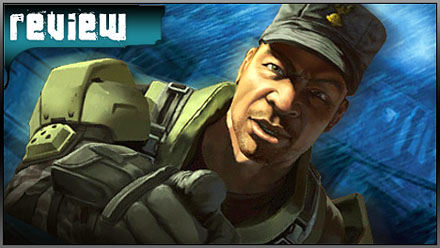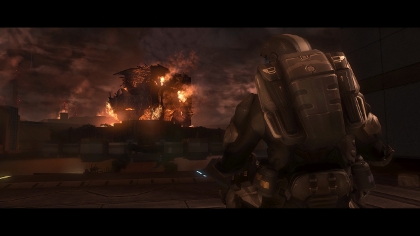When Bungie invited us to “finish the fight” back in the winter of 2007, only a madman would have believed that we had seen the last of the Covenant. You simply don’t take the biggest triple A single-format series of the decade outback and shoot the cash-cow in the head. Tasking itself with creating a follow-up to “the biggest entertainment launch of all time” Bungie have sidestepped a full-blown sequel along with the weighty expectations and budgetary requirements that come with it, instead focusing on a leaner, more focused view of Halo’s grand narrative.
As the title implies, this is an expansion of Halo 3, and as such the focus will be on the new. There can be very few Xbox 360 owners who aren’t intimately familiar with Master Chief’s antics, but the titular ODSTs (Orbital Drop Shock Troopers or Helljumpers to give them their punchier nick-name) have been given little screen time in the Halo series so far. What do they bring to the table?
Much has been made of their inferior abilities when stacked up against the Chief, but in reality they barely alter the battle-tested Halo formula one bit. Yes, they may not be able to jump as far or move as fast, but the game’s design accommodates this. Yes, the recharging shields that Halo turned into a near industry standard have gone, but the stamina gauge works so similarly that players will rarely stress over having to grab one of the many medikits dotted around the environment.
Perhaps the ODST’s greatest addition is the VISR (Visual Intelligence System Reconnaissance) HUD that not only changes the way the game is played, but really defines ODSTs distinct visual presentation. Essentially night vision goggles of the future, one touch of the X button draws beautifully stylised colour-coded outlines around everything onscreen, allowing enemies to be targeted effectively in the dark, drawing attention to important story-driving items, and most strikingly, adding an amazing depth of field to the game’s beautifully war-torn environments. While clearly not as progressive or well executed as Metroid Prime’s array of gameplay driven visors, it gives ODST a stunningly abstract visual quality that clearly separates it from its prequels. The VISR is introduced subtly, with early uses limited to exploring the game’s night time central hub, with each flashback pulling you further and further into the night where its application becomes essential.







 Satoru Iwata Video Interview - the late Nintendo president spoke with Kikizo in 2004 as 'Nintendo Revolution' loomed.
Satoru Iwata Video Interview - the late Nintendo president spoke with Kikizo in 2004 as 'Nintendo Revolution' loomed. Kaz Hirai Video Interview - the first of Kikizo's interviews with the man who went on to become global head of Sony.
Kaz Hirai Video Interview - the first of Kikizo's interviews with the man who went on to become global head of Sony. Ed Fries Video Interview - one of Xbox's founders discusses an epic journey from Excel to Xbox.
Ed Fries Video Interview - one of Xbox's founders discusses an epic journey from Excel to Xbox. Yu Suzuki, the Kikizo Interview - we spend time with one of gaming's most revered creators.
Yu Suzuki, the Kikizo Interview - we spend time with one of gaming's most revered creators. Tetris - The Making of an Icon: Alexey Pajitnov and Henk Rogers reveal the fascinating story behind Tetris
Tetris - The Making of an Icon: Alexey Pajitnov and Henk Rogers reveal the fascinating story behind Tetris Rare founders, Chris and Tim Stamper - their only interview? Genuinely 'rare' sit down with founders of the legendary studio.
Rare founders, Chris and Tim Stamper - their only interview? Genuinely 'rare' sit down with founders of the legendary studio. The History of First-Person Shooters - a retrospective, from Maze War to Modern Warfare
The History of First-Person Shooters - a retrospective, from Maze War to Modern Warfare